| Article ID | Journal | Published Year | Pages | File Type |
|---|---|---|---|---|
| 5871993 | Clinical Nutrition ESPEN | 2016 | 5 Pages |
SummaryBackgroundNutritional problems are frequent among patients with neuromuscular diseases, who consequently need an adequate evaluation. Objective: to describe nutritional assessment and to estimate and measure body composition and energy requirement in children with neuromuscular diseases.Subjects and methodsWe performed anthropometry, skinfold measurement and bioelectric impedance analysis (BIA) for estimate and measure, respectively, fat mass (FM). Resting energy expenditure (REE) was estimated by Schofield equations and measured by indirect calorimetry (IC). We compared actual energy intake with post-assessment recommendations.ResultsWe studied 40 patients, 13.6 ± 3.3 years old (Range: 5.8-19.3), 80% boys, diagnosed with Duchenne Muscular Dystrophy (n = 21), other dystrophies (7), Muscular Spinal Atrophy (7), myopathies (3) and others (2). According to body mass index (BMI) 22.5% were well nourished (zBMI â1 to +1), 17.5% overweight (zBMI +1 to +2), 17.5% obese (zBMI â¥Â +2), and 42.5% undernourished (zBMI < â1). Estimated FM was 20.2% (3.6-46.3), lower than BIA measurement: 34.2% (9.6-60.5) p < 0.001. Estimated REE was higher than measured REE: 1325 (813-2244) vs. 1202 (900-2100) kcal/day, p = 0.002. Actual energy intake: 1452 (1033-2476) was higher than recommended: 1300 (900-1900) kcal/day, p < 0.001.ConclusionUndernutrition and overweight are prevalent in this group of children with neuromuscular diseases. Clinical assessment underestimates FM and overestimates REE.
